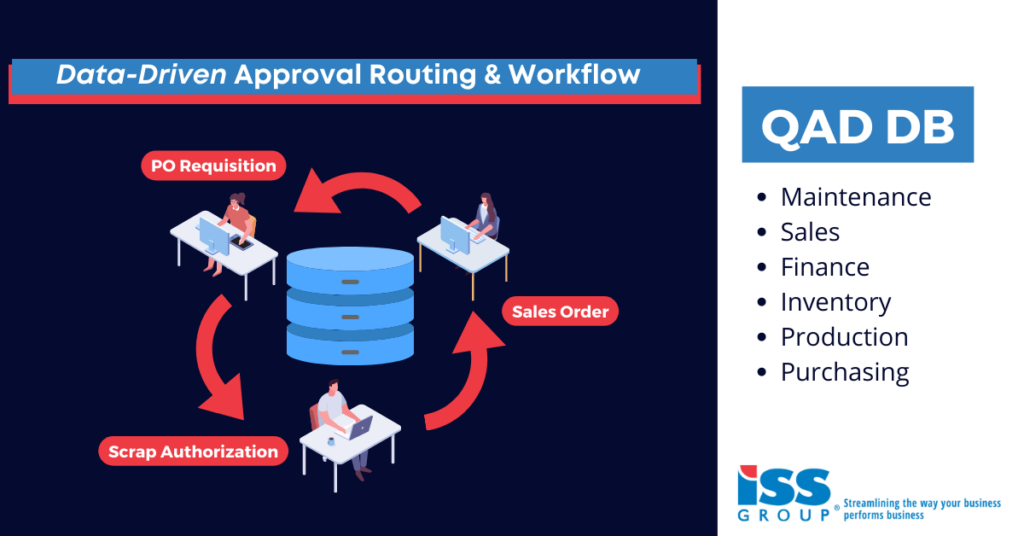In today’s fast-paced corporate world, time, accuracy, and efficiency are essential factors that determine the success of any business. The ability to quickly and accurately complete tasks while minimizing errors can make all the difference in achieving business objectives and staying ahead of the competition.
Therefore, it’s critical for businesses to optimize their business processes, including approval routing and workflows, to save time, improve accuracy, and increase efficiency. Approval routing and workflow involves multiple steps, such as submitting a request, assigning the request to an appropriate approver, and reviewing and approving the request. In a manual process, these steps can be time-consuming and error-prone, causing delays and reducing efficiency.
What is ‘Data-Driven’ Approval Routing and Workflow for QAD ERP?
Functionality that creates and alerts a list of Approvers based on the data associated with QAD ‘Integrated Processes’ – a Process that utilizes QAD datapoints, and then performs an Action upon final approval or rejection of that Process Request.
Data-Driven approval routing and workflow technology allows QAD end-users the ability to create Process Requests and configure rules to route those requests to appropriate recipients for Approval or Rejection of that request.
The approval process involves a requestor submitting a request for approval, which is then reviewed and approved by one or more approvers.
With a Data-Driven Approval Routing and Workflow solution, the request is automatically routed to the appropriate approver(s) based on predefined rules and parameters, such as the nature of the request, the requester’s department, or the amount of money involved. This automation reduces the time and effort required to manage approvals and helps to eliminate errors or inconsistencies that may occur in a manual process.

Examples of QAD Integrated Processes:
- Purchase Order Approval
- Supplier Invoice Approval
- Customer Sales Quote Approval
- Financial Requests (ie; Project Budgets, Credit Authorizations)
- Inventory Requests (ie; Unplanned Issues/Receipts, Lot Hold/Release)
- Production Requests (ie; Scrap Authorization, Assembly Rework)
- Shipping Requests (ie; Freight Authorizations)
- Master File Maintenance (Customer, Item, Supplier, …)
Data-Driven Workflow and Approval Routing Benefits
- Consistency: A data-driven solution can enforce consistent rules and policies across all approvals and workflows. By removing any ambiguity or subjectivity in the approval process, it can help reduce errors and ensure that all requests are handled consistently and accurately.
- Automation: With a data-driven solution, approvals and workflows can be automated based on predefined rules and parameters. This reduces the likelihood of human error and ensures that each request is processed accurately and efficiently.
- Analytics: A data-driven solution can collect and analyze data on approval and workflow performance, such as approval times, rejections, and bottlenecks. By using this data to optimize the approval process, the solution can improve accuracy and reduce errors over time.
- Visibility: A data-driven solution can provide real-time visibility into the approval process, allowing stakeholders to track the progress of their requests and identify any issues or delays. This visibility can help prevent errors and ensure that all requests are processed accurately and in a timely manner.
Data-Driven Approval Routing and Workflow Operating Principles
These Principles are a set of best practices for implementing a data-driven approval routing and workflow solution that leverages data and analytics to optimize accuracy, efficiency, security, and performance.
Overall, a data-driven approval routing and workflow solution can help organizations streamline their business processes, reduce errors, and improve accuracy by enforcing consistent rules, automate approvals, analyze performance, and provide real-time visibility. By implementing such a solution, you gain valuable insights into performance metrics which allow your organization to optimize business processes and identify areas for improvement.








